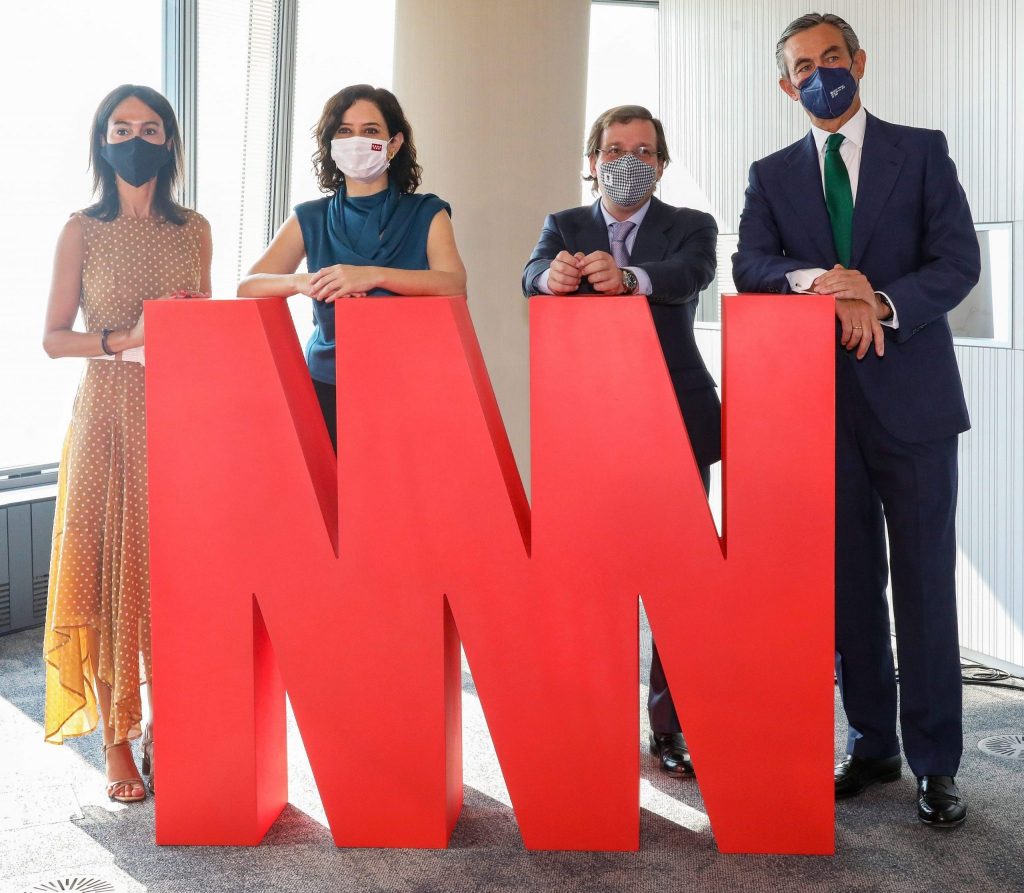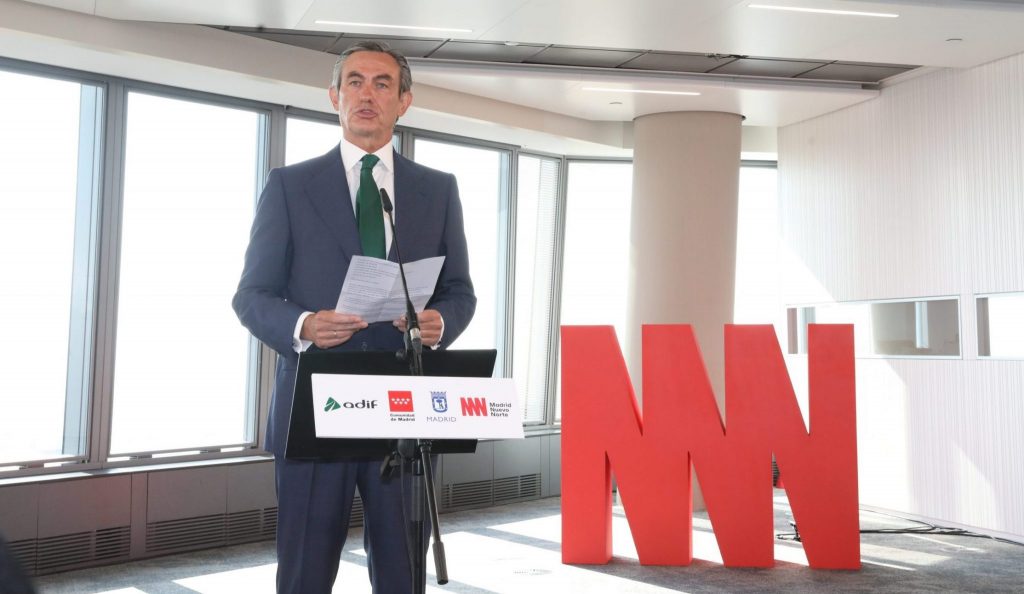20 July 2021
for Madrid Nuevo Norte

Today, the president of the Region of Madrid, Isabel Díaz Ayuso, the mayor of Madrid, José Luis Martínez-Almeida, the president of ADIF, Isabel Pardo de Vera and the president of Distrito Castellana Norte (DCN), Álvaro Aresti, signed the framework agreement for Madrid Nuevo Norte. The signing of this document is a milestone for the project. It represents the final step in the planning phase, allowing the project to move on to the urban management phase.
This agreement regulates the collaboration and coordination between the public administrations and DCN to execute key infrastructure for the project and for the entire city. These include remodelling important traffic hubs in the capital, renovating Chamartín Station, covering the railway tracks, new transport interchanges, a new Metro line and relocating and improving the city’s water supply installations.
In the words of DCN’s president, “today, we passed one of the most important milestones for Madrid Nuevo Norte to soon become a reality”. “Today, the planning phase of the project is definitively closed and we now enter the urban management phase, prior to the start of the works, the first time that this has been achieved in the long history of this project,” said Aresti.
Aresti stressed that the agreement and its implementation “will make it possible to develop state-of-the-art infrastructure that will put our region at the forefront of sustainable urban planning and improve the quality of life of millions of people”. “Madrid Nuevo Norte is a ground-breaking urban model that is firmly focused on sustainable mobility, energy decarbonisation and conserving natural resources and values”, said the president of DCN.
The President of the Region of Madrid, Isabel Díaz Ayuso, stressed the importance of this agreement and the collaboration between public administrations and private companies that will be needed to move forward with the project. For the regional president, this agreement represents “one of the largest exercises in public-private collaboration in our history” and it and will help start important infrastructure projects as soon as possible. Díaz Ayuso emphasised that the unique actions regulated by the agreement signed today are “necessary to attract companies, international institutions, investment and talent thanks to the Madrid Nuevo Norte Central Business District”. The President pointed out that Madrid Nuevo Norte, a project that is “a symbol of structuring, modernity and prosperity” is no longer a project for the future, but rather “is a reality for citizens today”.
The Mayor of Madrid, José Luis Martínez-Almeida, highlighted the “extraordinary importance” of the document that was signed today, because “it moves us fully into the project management stage“ and means “we might be able to see work on the land of Madrid Nuevo Norte shortly”. For Madrid’s mayor, “the collaboration between administrations and the private sector, in this case DCN, is what has made it possible”.
For the president of Adif, Isabel Pardo de Vera, the opportunity to sign the infrastructure framework agreement gives her “great satisfaction” because its objective is to “transform this urban landscape to improve people’s lives“, she stressed. Adif’s president highlighted the value of the consensus between institutions and companies, which will be embodied by the “monitoring committee in which all parties will be represented”. Pardo de Vera also stressed the importance of the future Chamartín Station, which will be “the heart of Madrid Nuevo Norte and the heart of Europe, an architectural icon, a new transport hub and a benchmark for sustainability”.

All of the parties involved stressed the importance of the consensus between Administrations and with private enterprise to make Madrid Nuevo Norte a reality.
The framework agreement is a public-private collaboration instrument through which the parties developing Madrid Nuevo Norte agree to coordinate the execution of key infrastructure for the project and for the entire city. Specifically, according to the agreement of 25 March 2020 of the Governing Council of the Region of Madrid, giving final approval to the Modification of the General Plan with the detailed planning of Madrid Nuevo Norte, the agreement has two objectives. The first is to establish a collaborative framework to ensure compatibility and coordination between the special actions of Madrid Nuevo Norte and the urban development works in each of the four areas of action of the project.
The second objective is to enable the start of the urban development management of the entire project, with the exception of the Chamartín Station area (RPA 05.10), requires the processing of the corresponding detailed urban planning instrument.
This agreement will also optimise the management and execution processes, decreasing the consumption of both public and private resources.

The president of DCN thanked the institutions and technical teams whose involvement made the agreement possible.
The agreement signed this morning regulates the infrastructure of Madrid Nuevo Norte that extends beyond each of the four areas of action, as well as other actions connected to the project and are important for its execution. Some of these actions, which are not regulated in the planning of Madrid Nuevo Norte, but are proposed in the modification of the General Plan, include, for example, remodelling and improving the North and Fuencarral interchanges and covering of the final stretch of the Castellana, both by the City Council.
Other examples of actions regulated by this agreement are the remodelling of the Chamartín Station railway complex; the covering of the tracks around the station, as well as other smaller covering projects planned in the area; the creation of a new Cercanías commuter rail station and the remodelling of the existing station and the construction of the new Chamartín underground multimodal transport interchange, as well as the improvement and extension of Metro line 10 and the renovation of the Canal de Isabel II infrastructure.
Coordination between all of the agents involved in the execution of this infrastructure is essential because of its importance not only for the development of Madrid Nuevo Norte, but for the whole city and the region of Madrid, as a whole.
By signing of the framework agreement, the parties involved agree to draft a Coordination and Implementation Plan that will include an action programme for each one of the infrastructures and works involved. The plan will be drawn up according to the guidelines and under the supervision of the technical services of the public entities that have signed the Agreement. To this end, a Technical Committee will be formed, with at least one representative from each of the parties participating. In addition, in order to guarantee full coordination of the actions regarding.